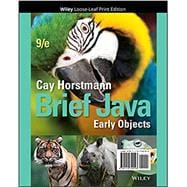Brief Java: Early Objects, 9th Edition focuses on the essentials of effective learning and is suitable for a two-semester introduction to programming sequence. This text requires no prior programming experience and only a modest amount of high school algebra. Objects and classes from the standard library are used where appropriate in early sections with coverage on object-oriented design starting in Chapter 8. This gradual approach allows students to use objects throughout their study of the core algorithmic topics, without teaching bad habits that must be un-learned later.
Choosing the enhanced eText format allows students to develop their coding skills using targeted, progressive interactivities designed to integrate with the eText. All sections include built-in activities, open-ended review exercises, programming exercises, and projects to help students practice programming and build confidence. These activities go far beyond simplistic multiple-choice questions and animations. They have been designed to guide students along a learning path for mastering the complexities of programming. Students demonstrate comprehension of programming structures, then practice programming with simple steps in scaffolded settings, and finally write complete, automatically graded programs.
The perpetual access VitalSource Enhanced eText, when integrated with your school’s learning management system, provides the capability to monitor student progress in VitalSource SCORECenter and track grades for homework or participation.
- Enhanced eText and interactive functionality available through select vendors and may require LMS integration approval for SCORECenter.








